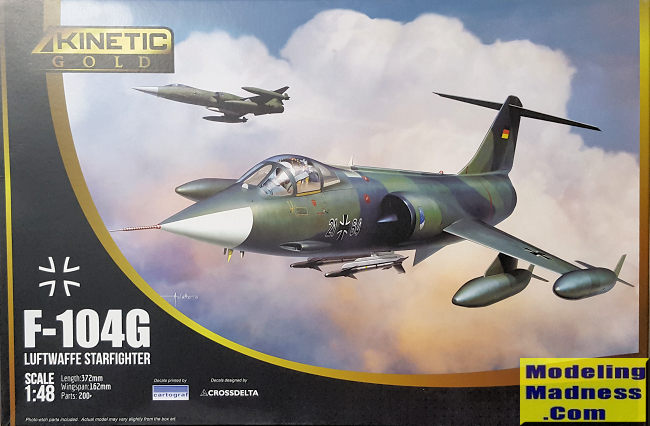
Kinetic 1/48 F-104G Luftwaffe Starfighter
| KIT #: | K48083 |
| PRICE: | $42.00 delivered from Hong Kong |
| DECALS: | Three camo options |
| REVIEWER: | Scott Van Aken |
| NOTES: | 2019 release |

| HISTORY |
In response to a 1957 German Air Staff Paper asking for a single aircraft to fulfill its fighter, fighter-bomber, and reconnaissance mission requirements, Lockheed redesigned the entire airframe, including 96 new forgings, additional skin panels, and reinforced landing gear with larger tires and improved brakes. The proposed F-104G (for Germany) "Super Starfighter" featured a more powerful J79-11A engine, a larger tail with powered rudder (the same used on the two-seat F-104B and D), improved blown flaps with a mode for improved maneuverability, electric de-icing equipment for the air intake inlets, and a larger drag chute. Avionics were improved as well, primarily with the Autonetics F15A NASARR (North American Search and Range Radar) multi-mode radar and the LN-3 inertial navigation system by Litton Industries, the first such system to be placed into operational service. Altogether, these changes increased the amount of external weapons that could be carried to 3,000 lb (1,400 kg), and also allowed the aircraft to fulfill the NATO requirement of carrying a 2,000 lb (910 kg) "special store" (nuclear weapon) under the fuselage.
Belgium, the Netherlands, and Italy selected the F-104 soon after as well, and the four European nations set up four production groups to jointly manufacture the F-104G under license. Arbeitsgemeinschaft (ARGE) South consisted of Messerschmitt, Heinkel, Dornier, and Siebel; ARGE North comprised Hamburger Flugzeugbau, Focke-Wulf, and Weserflug in Germany, as well as Fokker and Aviolanda in the Netherlands; the West Group was made of SABCA and Avions Fairey in Belgium; and the Italian Group was formed of Fiat, Macchi, Piaggio, SACA, and SIAI-Marchetti. The four groups were contracted to manufacture 210, 350, 189, and 200 F-104G aircraft, respectively. In addition, 1,225 J79 turbojets were also produced under license by BMW in Germany, Fabrique Nationale in Belgium, and Alfa Romeo in Italy. Canada, who had also chosen the Starfighter to fulfill its NATO obligations, delivered 121 sets of wings, aft fuselages, and tail assemblies built by Canadair to Europe while it constructed 200 CF-104s with Orenda-built engines for the Royal Canadian Air Force. Later the two would also build an additional 110 MAP-funded F-104Gs destined for Europe. Lockheed for its part built 191 two-seat trainers for both Europe and Canada, as well as supplying spares and technical support.
In all, 2,578 F-104s were produced by Lockheed and under license by various foreign manufacturers. Though out of service for many years, several are still flying with civil registration.
| THE KIT |
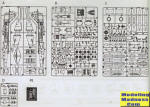 Kinetic
has done the full range of F-104s and they have been well received. This is one
of their earlier releases and provides the bits needed to do the F-104G as flown
by the Luftwaffe. I very much like that Kinetic offered a full fuselage half
instead of splitting the fuselage to enable all the variants to be done with a
basic forward section and separate tail sections.
Kinetic
has done the full range of F-104s and they have been well received. This is one
of their earlier releases and provides the bits needed to do the F-104G as flown
by the Luftwaffe. I very much like that Kinetic offered a full fuselage half
instead of splitting the fuselage to enable all the variants to be done with a
basic forward section and separate tail sections.
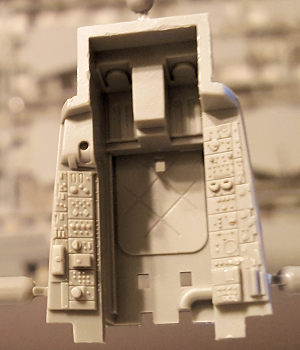 Detailing
of the kit is first rate with fine engravings and some recessed rivet detailing.
The cockpit is very nicely done with a multi-piece bang seat and p.e. harness.
Unlike several model companies, Kinetic does not offer a decal for the
instrument panels so those areas will need to be painted. Once the cockpit is
built, construction turns to the exhaust, nose gear well,
Detailing
of the kit is first rate with fine engravings and some recessed rivet detailing.
The cockpit is very nicely done with a multi-piece bang seat and p.e. harness.
Unlike several model companies, Kinetic does not offer a decal for the
instrument panels so those areas will need to be painted. Once the cockpit is
built, construction turns to the exhaust, nose gear well,
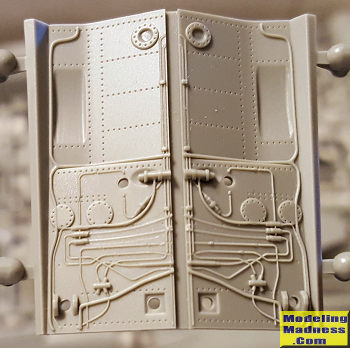 main gear
well, and nose cone. Again, the wells are nicely detailed and perfect for those
who like to pick out details. Before installing these items in the fuselage, one
has to open the holes for the missile rails.
main gear
well, and nose cone. Again, the wells are nicely detailed and perfect for those
who like to pick out details. Before installing these items in the fuselage, one
has to open the holes for the missile rails.
Then the rest of the fuselage is built up which includes the cockpit anti-glare panel, the lower fuselage sections, the horizontal stab, and the engine intakes.
The next construction steps cover the assembly and installation of the landing gear and doors. The main gear are fairly complex and unlike many 104 kits, each side of the main gear is a separate construct. At the rear, there is a ventral fin, tail hook, and speed brakes to install. The latter can be open or closed.
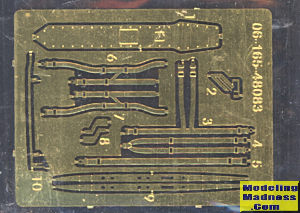 Wings
have separate flaps, slats, and ailerons. You can pose the flaps lowered if you
wish. Holes will need to be opened for the wing pylons. The canopy and the section behind it can be posed open if
you so wish and it was not unusual to see this aft bit open during pre- and
post-flight operations. The final bits are drop tanks, wing tip tanks, and pylons
as well as the fuselage missile rack and missiles.
Wings
have separate flaps, slats, and ailerons. You can pose the flaps lowered if you
wish. Holes will need to be opened for the wing pylons. The canopy and the section behind it can be posed open if
you so wish and it was not unusual to see this aft bit open during pre- and
post-flight operations. The final bits are drop tanks, wing tip tanks, and pylons
as well as the fuselage missile rack and missiles.
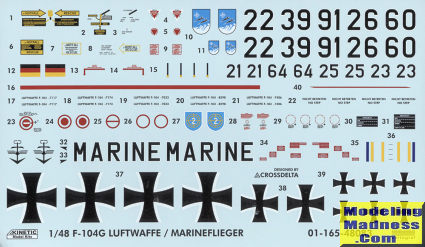 Instructions
are well done and provide colors using MiG paints. FS 595 and generic names are
also given. Markings are for three different camouflage schemes. The box art is
the last scheme worn by these planes and is with JBG 34. Several serial options
are provided for this and the earlier splinter pattern camouflage, also with JBG
34. The third scheme is grey over silver which was worn by MFG 2. Decals are
nicely done and work well as I discovered with my F-104A build. There are plenty
of aftermarket options for an F-104G if you want something different. If I had a
complaint with the instructions it is that the printing on the late scheme is so
dark that you cannot differentiate between the dark green and the NATO black.
This will require some other source to see the demarcation lines between these
shades.
Instructions
are well done and provide colors using MiG paints. FS 595 and generic names are
also given. Markings are for three different camouflage schemes. The box art is
the last scheme worn by these planes and is with JBG 34. Several serial options
are provided for this and the earlier splinter pattern camouflage, also with JBG
34. The third scheme is grey over silver which was worn by MFG 2. Decals are
nicely done and work well as I discovered with my F-104A build. There are plenty
of aftermarket options for an F-104G if you want something different. If I had a
complaint with the instructions it is that the printing on the late scheme is so
dark that you cannot differentiate between the dark green and the NATO black.
This will require some other source to see the demarcation lines between these
shades.
| CONCLUSIONS |
This will make into a very nice kit. It has a good amount of detail and as such will require some careful building as some of the bits are quite small. I would have liked for the kit to include instrument decals and for the camo printing to be clearer. This kit by no means makes the Hasegawa offering obsolete, it just ups the ante on detail. I've included an image of the F-104A/C I did earlier so you can get an idea of how nice the kit is.
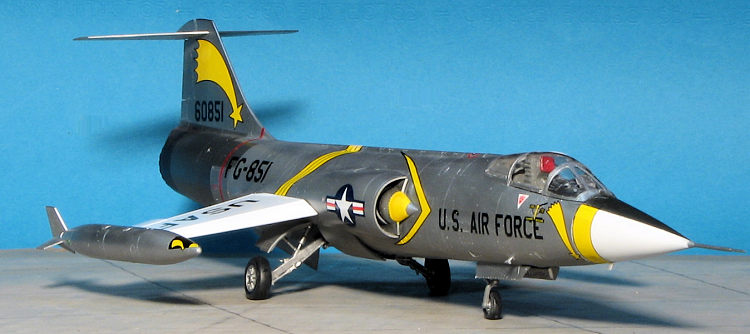
| REFERENCES |
https://en.wikipedia.org/wiki/Lockheed_F-104_Starfighter
January 2024 Copyright ModelingMadness.com. All rights reserved. No
reproduction in part or in whole without express permission from the editor.
If you would like your product reviewed fairly and fairly quickly, please
contact
the editor or see other details in the
Note to
Contributors.